|
 April 7, 2023
|
|
 Torrey Pines State Natural Reserve
A stunning view from the Broken Hill Overlook.
Photo from Barbara Green, San Diego Coast District

|
|
Celebrate the Second Annual California State Parks Week, June 14-18
Story from: Communications and Marketing Division
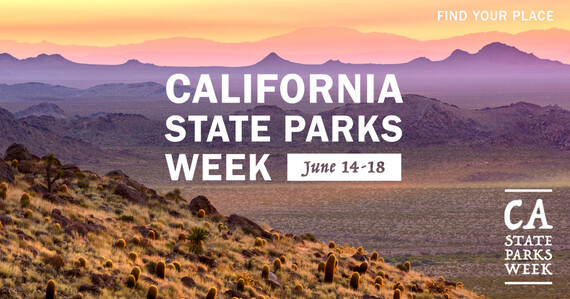 For more information on the week, visit CAStateParksWeek.org.
California State Parks along with partners Save the Redwoods League, Parks California and the California State Parks Foundation invites the public to celebrate the second annual California State Parks Week on June 14-18.
This weeklong event celebrates California’s 280 state parks and the people who visit and help protect these iconic places. Parks from across the state will be offering special community events as well as in-person and virtual programming.
“We are excited to host the second annual California State Parks Week and build upon last year’s inaugural successes,” said Armando Quintero, director of California State Parks. “California State Parks Week serves as a reminder that state parks belong to all who call California home. Everyone deserves to enjoy them, to stay healthy and active, find inspiration and connect with nature and areas of cultural significance.”
Launched in 2022, California State Parks Week offers a full week of specially themed days with in-person and virtual activities and events in parks across the state. In its inaugural year, California State Parks week welcomed visitors to all 280 parks to participate in more than 143 events statewide. A complete list of the week’s events and how to participate are available at CAStateParksWeek.org.
The 2023 California State Parks Week themed days are:
-
Wednesday, June 14: Explore New Experiences With 280 state parks that offer everything from the magic of ancient redwood forests to epic beach days, we encourage everyone to visit a state park and try something new. California State Parks Week is your invitation to explore a new activity—or a new park—you might fall in love with. View all events.
-
Thursday, June 15: Nourish Your Health and Well-being Studies have shown that time in nature can boost our physical, mental and emotional well-being. California’s state parks give all of us places where we can find refuge, inspiration, challenges and joy. View all events.
-
Friday, June 16: Support Climate Resilience California’s forests, oceans, grasslands and other ecosystems are not just beautiful—they store huge amounts of carbon, making them some of the most powerful tools in adapting to climate change. We invite you to explore a park near you and learn about how to support California State Parks and its partners’ efforts to expand protected areas and restore forests and wetlands to build resilience in the landscapes that help protect us all. View all events.
-
Saturday, June 17: Celebrate Community and Culture California’s state parks are for everyone. We reaffirm this truth by elevating the perspectives and experiences of communities that have historically been underrepresented in public lands. Join us for celebrations and cultural events that honor Black, Indigenous and communities of color at parks statewide. View all events.
-
Sunday, June 18: Care for Our Shared Lands It takes our full community to care for public lands. Partners and volunteers are vital to keeping California’s State Park System healthy, beautiful and rich in biodiversity. Discover how you can get involved in efforts to protect and steward California’s state parks—as a professional staff member, volunteer, partner or through one of many other opportunities. View all events.
California State Parks Week advances the Outdoor Access for All initiative championed by Governor Gavin Newsom and First Partner Jennifer Siebel Newsom, as well as the California Outdoors for All initiative. These efforts expand outdoor access to all Californians through focused investments in open space infrastructure, outdoor programming and improvements to permit applications, with a priority to expand access in underserved communities.
Read more in the press release.
California Marks Progress, Historic Investments to Protect People and Nature From Climate Change Threats
Story from: California Natural Resources Agency
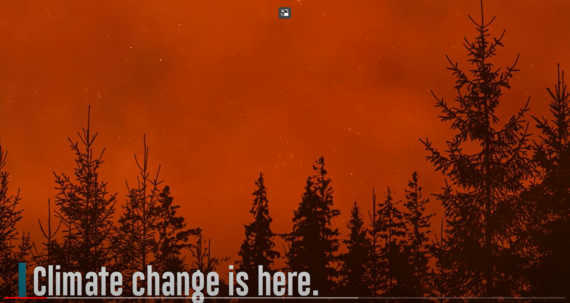 Click above or on button below to watch video about the state's 2023 Climate Adaptation Strategy.
The Newsom Administration issued a progress report Wednesday, April 5, on actions over the past year to build climate resilience across California. Guided by the state’s Climate Adaptation Strategy, California is leading the way with comprehensive and innovative actions to adjust to changes and protect the most vulnerable communities from accelerating climate threats.
The report shows nearly three-quarters of the Strategy’s 350+ metrics across nearly 150 actions are well underway, ongoing or completed, with the remaining metrics in the early stages of scoping or beginning project work. See the progress here.
Reducing climate risks and building long-term resilience are top priorities for the Newsom Administration. Millions of Californians continue to feel the destructive effects of climate change. In the past year alone, the state experienced severe drought, a record-shattering heatwave and devastating floods driven by extreme weather.
California is taking historic action to reduce these risks. Major investments are beginning to pay off, including those focused on increasing water resilience and protecting Californians from catastrophic wildfire.
Through the nearly 150 actions outlined in the Climate Adaptation Strategy, state agencies are coordinating across all sectors to reduce climate risks while emphasizing six priorities:
- Strengthen protections for climate vulnerable communities.
- Bolster public health and safety to protect against increasing climate risks.
- Build a climate-resilient economy.
- Accelerate nature-based climate solutions and strengthen climate resilience of natural systems.
- Make decisions based on the best available climate science.
- Partner and collaborate to leverage resources.
Progress in each area is being measured through specific metrics, which were included in the Strategy for the first time in 2021. Updates on all the Strategy’s metrics are tracked at https://www.climateresilience.ca.gov/.
To read the full press release, click here.
  
|
|
New Face for History Log at Humboldt Redwoods State Park
Story from: Cleo Mae Domingo, North Coast Redwoods District
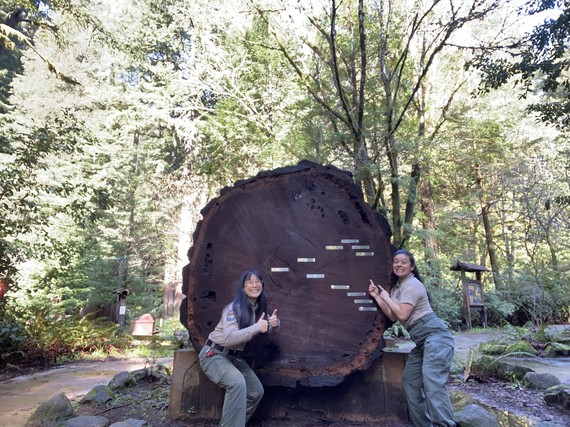 Watershed Interpreter Cleo Mae Domingo and Interpreter I Erika Granadino posing after installing the new plaques at Humboldt Redwoods State Park. Photo from Erika Granadino, North Coast Redwoods District.
The Redwood History Log is an interpretive display that sits in front of the Humboldt Redwoods State Park Visitor Center. This slice of coast redwood, which is 76 inches in diameter, lays on its side to display its growth rings, with the oldest—at the center—going back about a thousand years. Plaques on the log mark dates in the tree’s growth and connect them to historical milestones of the same year. For example, plaques had captions such as “1492 Columbus Discovers America” or “1849 Humboldt Bay Discovered by Land.”
In recent years, plaques started disappearing, as the interpretation of the historical events became more controversial. People debated whether the plaques reflected an uncritical attitude toward the history of colonialism. Another discussion centered around the events’ relevance to the park itself. The Redwood History Log needed to be adjusted to reflect our changing perspectives on the past.
State Parks employees across the department helped in updating the log. Maintenance and Trail staff removed the remaining plaques and cut a fresh face into the redwood log. Interpretation staff researched and drafted new dates and events with the help of Cultural Resources staff and interpretation students from several California State Universities.
The new plaques more closely relate to the local cultural and natural history. The captions now connect the tree rings to the history of logging, forestry and conservation, and pay tribute to the contributions of local California Native Americans instead of the general history of European discoveries.
The new Redwood History Log was reconceived so that many more visitors can enjoy and learn from it!
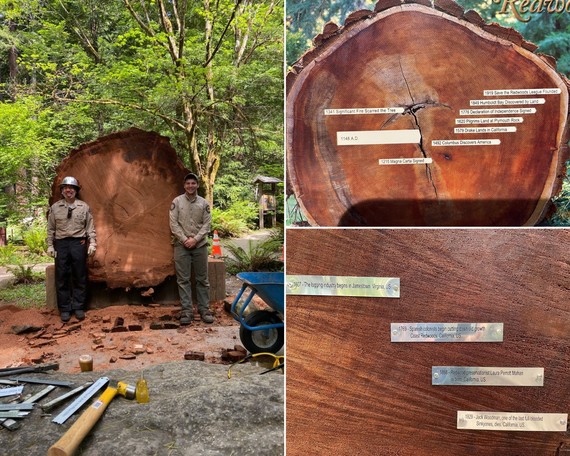 Left: Skilled Laborer Yony Rivas and Forestry Aide Abe Eudy in front of the log after giving it a fresh cut. Top right: The Redwood History Log prior to its update. Bottom right: A few of the newly updated plaques. Photos from Erika Granadino and Cleo Mae Domingo, North Coast Redwoods District.
Four More K-9s Graduate Training and Join State Parks
Story from: Ben Ellis, San Luis Obispo Coast District
 Left to right: K-9s Ghost, Doc, Jerry and Zuma.
California State Parks is getting four new K-9s, as Doc, Jerry, Zuma and Ghost graduated from the Top Dog training school in Ripon, California, on Thursday, March 16.
Being a part of a K-9 team is one of the longest specialty assignments for a law enforcement officer. Basic training lasts five weeks, but for dual-purpose K-9s trained in patrol and detection, the training is eight weeks, or 320 hours of training.
Searching for, finding and apprehending suspects; protecting their handlers; listening to commands; and not engaging a suspect after being called off are just some of the areas our new handlers and their K-9s had to train and test in for patrol training.
On top of all that, all four of these dogs are trained and certified in explosives detection. This requires the K-9s to find and silently alert their partner when they detect any of the 16 types of explosives that they are trained with. This includes performing preliminary bomb sweeps for events and dignitaries.
State Parks welcomes our four newest K-9 teams, all cross-trained in patrol and explosives detection:
- State Park Peace Officer (SPPO) Thomas Cunningham and K-9 Doc are assigned to San Luis Reservoir State Recreation Area in the Central Valley District. Doc is a black and tan German shepherd born on Aug. 1, 2021. Doc loves protecting the extraordinary biological diversity and culture resources for the State of California. He also makes sure to take time to visit the California State Park Junior Lifeguard community. Off duty, he lives at home with Officer Cunningham and his two “brothers,” Byrd and Ben. When not at work, Doc enjoys a good game of fetch and a lazy afternoon with his family. Doc is the third canine member to join the State Park Peace Officer (Lifeguard) Program.
- SPPO Benjamin Ellis and K-9 Jerry are both assigned to Hearst Castle in the San Luis Obispo Coast District. Jerry is a German shepherd born in Germany on July 5, 2021. While on duty, he is ready to find and apprehend uncooperative suspects while also protecting his partner. All of Jerry’s commands are in German. Off duty, Jerry lives at home with Officer Benjamin Ellis and his “brother,” Guinness the Staffordshire terrier, in Morro Bay, California.
- SPPO Andrew Bampton and K-9 Zuma are also assigned to Hearst Castle in the San Luis Obispo Coast District. Zuma is a German shepherd born on Sept. 7, 2020. Zuma is a patrol K-9 and is cross-trained in explosives detection. He is ready to find and detain uncooperative suspects and also protect his partner. All of Zuma’s commands are in German. Off duty, Zuma lives at home on the coast of Piedras Blancas with Officer Bampton, his family and his “brother,” Dooey the shih tzu.
- SPPO Kyle Meza and K-9 Ghost are a K-9 team assigned at Millerton Lake State Recreation Area in the Central Valley District. Ghost is a tan, sable-colored German shepherd born in Germany on Oct. 2, 2021. Ghost receives all of his commands in German and is trained and prepared to locate and apprehend uncooperative suspects, as well as protect his handler, other partners and the public. Ghost loves to meet new people and get scratches behind his ears whenever he can. His favorite game is playing keep-away with his toys. When Ghost is off duty, he lives at home with Officer Meza and his family.
Congratulations on your graduation, K-9s Doc, Jerry, Zuma and Ghost!
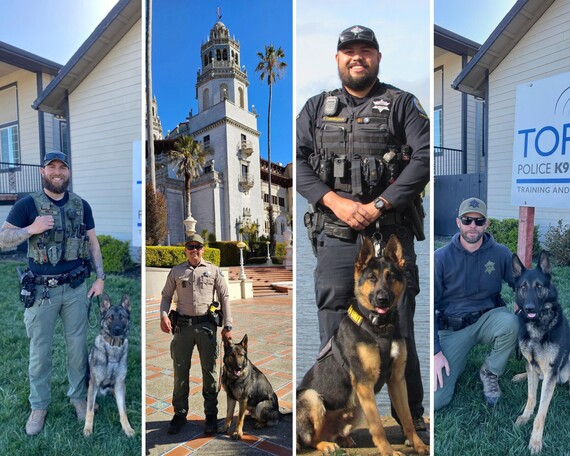 Left to right: SPPO Kyle Meza and K-9 Ghost, SPPO Benjamin Ellis and K-9 Jerry, SPPO Thomas Cunningham and K-9 Doc, and SPPO Andrew Bampton and K-9 Zuma.
New Equipment Installation During Appreciation Week Supports State Parks Communications Operators in Their Life-Saving Work
Story from: Doug Johnson, Law Enforcement and Emergency Services Division
 Top left: Communications Supervisor Joanne Lavelle at her workstation inside NORCOM. Top right: Communications Operator Bianca Gonzalez at her workstation inside NORCOM. Bottom: NORCOM’s front gate.
Both the Northern Communications Center (NORCOM) at Prairie City State Vehicular Recreation Area in Rancho Cordova, California, and the Southern Communications Center (SURCOM) at Lake Perris State Recreation Area in Perris, California, are getting a major upgrade. New InterTalk Critical Information System radio consoles are currently being installed in both locations.
“The brand of radios that we had went out of business. So, we no longer had support nor parts, and we had no way to keep those things up and running,” said State Parks NORCOM Superintendent II Steven Walloupe. “[This new system] gives us support for the next 20 years or more moving into the future.”
“We’re really making the largest technology upgrade in the history of the building,” said State Parks SURCOM Superintendent II Jake Pflepsen. “We’re really excited about that and look forward to providing high-quality services into the future.”
The timing for this new equipment could not be better. This year, April 9-15 is National Public Safety Telecommunicators Week. Dispatchers at both NORCOM and SURCOM said they were delighted by all the show of appreciation they got last year.
“I think I met 20-25 officers that week. They were bringing all sorts of food and gifts and appreciation … I was pleasantly surprised by the turnout of officers who came out to show their appreciation and support for their dispatchers,” said Joanne Lavelle, communications supervisor at NORCOM.
Unlike dispatchers at most communication centers, which often only cover a single city or county, NORCOM covers 43 counties in the northern two-thirds of the state and SURCOM covers 15 counties in the southern one-third. The communications centers can dispatch for each other to ensure adequate coverage.
“There’s a lot of geography to cover; whereas being a city dispatcher I know my city, it’s all I must know. Here I must know all the way from Oregon to Pfeiffer Big Sur. It’s a lot of ground to cover,” Lavelle said.
However, at NORCOM in January, that task became more challenging when high winds knocked out power and phone lines.
“The power had gone out and the phones had gone out, and it stayed that way for the next two days. We had ways of communicating with other agencies and letting them know, ‘hey, if you have an emergency for us, you need to call this cellphone’… we were able to send the teletype out statewide to let them all know,” said Lavelle.
It is that unpredictability dispatchers say they enjoy, adding that no two shifts on the job are ever the same.
“It’s the same basic function, but every second is not the same as the day before. Activity and call types change, and so you just never know what you’re going to get,” said Julie Higday, communications supervisor at NORCOM.
Walloupe and Pflepsen both say there are plenty of opportunities for them to add more dispatchers.
“We recently switched from an in-person state exam to an online exam, and we have final file dates at the end of every month right now. So, we’re really trying to build up our eligibility list … we’re actively recruiting and hiring and we will be for a while,” Walloupe said.
“We are definitely hiring,” said Pflepsen. “So, we encourage anyone who’s interested to look into taking those exams.”
Lavelle said, “It kind of makes you feel good knowing people are out having a good time at state parks and hopefully they’re safe, because if not that’s where we come in.”
Click here to learn more about the communications operator assessment and position.
 Top left: NORCOM’s radio tower. Top right: A new InterTalk Critical Information System radio console workstation. Bottom: Communications Supervisor Julie Higday at her workstation at NORCOM.
2023 Ching Ming Festival at Marshall Gold Discovery State Historic Park
Story from: Douglas Hsia, Locke Foundation, and Steve Hilton, Gold Fields District
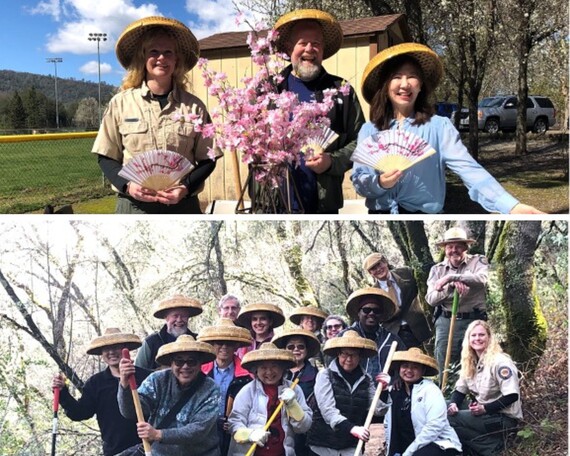 Top (left to right): Interpreter Holly Thane, Gold Fields District; Deputy District Superintendent Steve Hilton, Gold Fields District; and Mary Yin, Asian Pacific Islander American Public Affairs Association (APAPA). Bottom: Attendees clean up the Gam Saan Trail.
Mining at Gam Saan (Gold Mountain) was often perilous. When miners left China for America, mandatory fees were paid to associations to cover funerary rituals and expenses in case of an overseas death. Upon passing, bodies were placed within temporary shallow graves subtlety marked so kinsmen could pay their respects and exhume the remains a few years later for cleaning and preparation for shipment back home.
Near Marshall Gold Discovery State Historic Park is a setting with the American River flowing west, hillsides to the back, left and right, representing Green Dragon and White Tiger; this meets the feng shui requirements for a peaceful spiritual transition to the West where relatives and friends were anticipating a spiritual homecoming.
Once shipped back to China, human remains were permanently placed within an established cemetery where feng shui and proper burial rituals allowed the spirit to smoothly reach the gate of heaven. Without a smooth passageway, the spirits could be left out of the gate, becoming a homeless wandering ghost, a scenario to avoid at all costs. A spirit that smoothly reaches heaven takes care of their living descendants from above. A happy spirit is a good caretaker.
On Friday, March 24, representatives from several partnering organizations, including the Asian Pacific Islander American Public Affairs Association, Chinese Benevolent Association, the Locke Foundation and State Parks gathered to perform a Ching Ming ceremony near the Gam Saan Trail.
The Ching Ming (Pure Brightness) Festival is devoted to remembering and honoring those who have passed. This holiday is celebrated by cleaning and caring for gravesites, burning incense and money, and providing offerings of wine and food. Attendees cared for the trail to honor Chinese who once, at least temporarily, called Coloma and Lotus home. Attendees then celebrated with lunch in recognition of the many historic contributions of the Asian community.
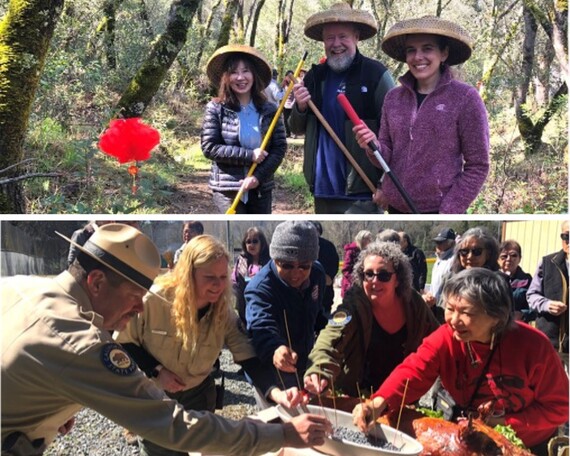 Top (left to right) Mary Yin, APAPA; Steve Hilton, Gold Fields District; and Denise Karapinar, executive director of the Gold Discovery Parks Association, sweeping the trail. Bottom: Attendees place incense as part of the offerings at the Ching Ming Festival.
 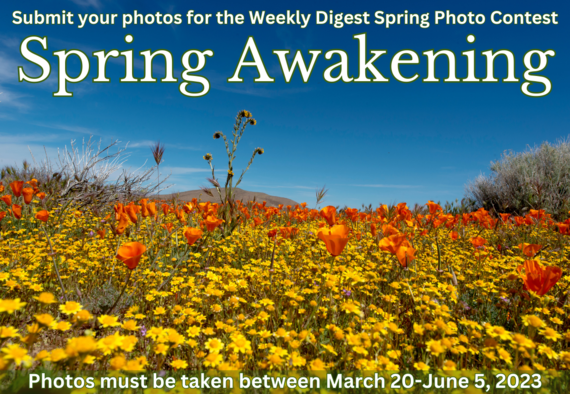 Email photos to the WeeklyDigest@parks.ca.gov.

|
|
|
To view current job openings within California State Parks, please visit our jobs webpage at www.LiveTheParksLife.com.
State Parks Job Spotlights and Open Exams
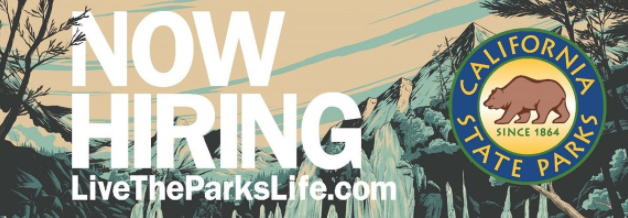 JOB SPOTLIGHTS
State Park Peace Officer Ranger/Pilots – Apply by April 7, 2023: We are now hiring two State Park Peace Officer Ranger/Pilots at Anza-Borrego Desert State Park in Borrego Springs. These positions require basic Peace Officer Standards and Training certification and a valid class C driver's license. Click here for more information.
State Park Interpreter I – Apply by April 13, 2023: We are hiring a State Park Interpreter I to lead school programs in San Diego. This position is responsible for the planning, research and development of K-12 interpretive programs for Old Town San Diego and San Pasqual Battlefield State Historic Parks. Click here for more information.
Attorney III – Apply by April 15, 2023: We are now hiring an Attorney III at our headquarters in Sacramento. This position acts as lead counsel to provide assistance to the Chief Counsel and the department regarding Cannabis Enforcement and Watershed Restoration matters and provides legal advice and assistance on legal activities associated with law enforcement issues. Click here for more information.
Seasonal/Part-Time: Multiple Opportunities – Apply-by dates vary: Now is a great time to get started in a seasonal/part-time job at California State Parks. With no exam needed, apply to our Park Aide, Maintenance Aide, Environmental Services Intern, Park Interpretive Specialist, Guide Trainee or Forestry Aide openings today. Click here for more information.
EXAM SPOTLIGHTS
Laborer – Continuous: Our California State Parks Laborers work on park restoration projects and help keep our parks safe and operational for all to enjoy. If you are interested in working outdoors and making a difference, apply for this exciting opportunity. The file-in-person locations and dates can be found in the assessment bulletin. Click here for more information.
Guide I, Historical Monument – Apply by April 15, 2023: The Guide I, Historical Monument, assessment is now available. If you have one year of experience in presenting to groups and equivalent to graduation from the 12th grade, apply to take this assessment. Click here for more information.
Supervisor, Cultural Resources Program – Apply by April 24, 2023: If you have experience as a Senior State Archeologist or State Historian III, or experience in the implementation of cultural resource management, planning and protection programs, apply for the Cultural Resources Program Supervisor assessment. Click here for more information.
Communications Operator – Continuous: Our California State Parks Communications Operators are emergency dispatchers who monitor emergency communications systems, answer calls for service, log incidents and dispatch field units to emergencies. Apply to take the Communications Operator assessment today and begin your State Parks career in this exciting and rewarding opportunity. Click here for more information.
Park and Recreation Specialist Series – Continuous: The Park and Recreation Specialist Series assessments are now available online. From creating new outdoor parks in California communities to leading outdoor recreation programs, the opportunities are endless. From entry level to management, explore our Park and Recreation Specialist Series assessments today. Click here for more information.
State Park Interpreter I, II and III – The State Park Interpreter I, II and III assessments have been rereleased and are available online. State Park Interpreters help develop interactive and educational programs to teach the rich histories of California. Click here for more information.
EMPLOYMENT TIP
It's all in the details! When completing your application, plug in details from the class specs AND the duty statement—our Certification Unit reviews all applications and informs hiring managers who is eligible for an interview.
If you have any questions regarding these opportunities, connect with us at Recruiting@parks.ca.gov. We’re happy to help!
Interested in more jobs and exams like this? Explore www.LiveTheParksLife.com to discover the possibilities.
Join the Parks Jobs mailing list here. We can send you updates on jobs and exams that interest you!
Greg Martin Named as New Desert Division Chief for Park Operations
Story from: Kathy Amann, Park Operations

I am pleased to announce that Greg Martin has joined my team as the new desert division chief for Park Operations. His official start date was Saturday, April 1.
As the chief of the Desert Division, Greg is responsible for the Channel Coast, Colorado Desert, Inland Empire, Great Basin and Ocotillo Wells Districts.
Greg has been a park professional since 1997 and has served the department in many capacities: park volunteer, interpretive specialist, ranger, supervising ranger, public safety superintendent, field training officer/supervisor/manager, academy instructor, sector superintendent (at Four Rivers and Calaveras), acting district superintendent for the Central Valley District and most recently, the district superintendent for the Channel Coast District. His involvement in and management of all the program areas has helped Greg prepare for this new leadership role. He is looking forward to working in California’s desert region and advocating for these special places.
Greg; his wife, Elisa; and two sons, Reagan and Mason, are avid park enthusiasts and enjoy traveling the country, visiting the many special places that share our nation’s history and protect our special landscapes.
Please join me in welcoming Greg to his new position.
|
Amber Sprock Named as New Central Valley District's Public Information Officer/Marketing Director
Story from: Danielle Gerhart, Central Valley District
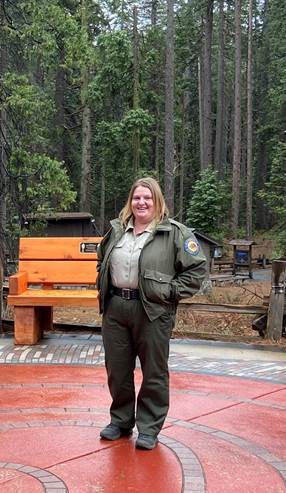
It is my pleasure to announce that Calaveras Big Trees State Park Interpreter Amber Sprock has accepted the park and recreation specialist position as the district’s public information officer/marketing director. This position has been vacant for a year, and I am thrilled to have Amber promote into such a fitting career change.
Amber is from a small, rural community Sacramento County and graduated from the University of California, Davis, with a degree in sociology. She began her career with California State Parks 16 years ago as a visitor services park aide. Amber first fell in love with connecting people to parks at Sutter’s Fort State Historic Park. She quickly transitioned from park aide to senior park aide and began to assist with the Environmental Living Program (ELP). Two years later, Amber became the coordinator of ELP as a park interpretive specialist. This position gave her experience in firing a cannon, coordinating a team and training teachers to bring their students on a 24-hour living history field trip.
In 2013, Amber was promoted to a guide at the California State Capitol Museum, where she connected with people from around the world and witnessed government in action. In addition to working for California State Parks, Amber worked as an event coordinator and accounting assistant for the cooperating association Friends of Sutter’s Fort.
In 2016, she became state park interpreter at the State Indian Museum and Sutter’s Fort State Historic Park, where she worked as part of the sector management team and Capital District’s leads and supervisors. In 2020, she joined the team at Calaveras Big Trees State Park as a state park interpreter and gained experience in natural resources and fell in love with giant sequoias. When not working and traveling, Amber likes spending time with her dogs, family and friends.
We look forward to having Amber assist with town hall meetings, emergency planning, public information and press releases, and coordination of outreach and recruitment events, among many other district support priorities. Amber has already proven herself as a stellar interpreter and leader in the district, and I look forward to seeing what expertise she will bring in her new role.
Congratulations, Amber!
|
 
|
|
|
Style time! Here are this week's tips to help spread the word about our departmentwide style guidelines:
-
springtime: One word, lowercase.
-
older adult(s), older person/people: Preferred over “senior citizens,” “seniors” or "elderly” as a general term when appropriate and relevant.
-
aid/aide: “Aid” is assistance; however, "aide" is a person who serves as an assistant. Use “aide” and not “aid” when referring to park aides, forestry aides, maintenance aides, etc.
Keeping a consistent writing style ensures the Weekly Digest looks and sounds its best. Each week, the Communications and Marketing Division reviews submitted articles for proper grammar and punctuation and style consistency––from capitalization and hyphenation to proper acronyms and active/passive voice usage. In general, we follow the Associated Press style and Merriam-Webster, but at times we use our own department-specific style.
We always welcome your feedback on how to “Live the Parks Life” in (writing) style. Connect with us via email at weeklydigest@parks.ca.gov.
|
|
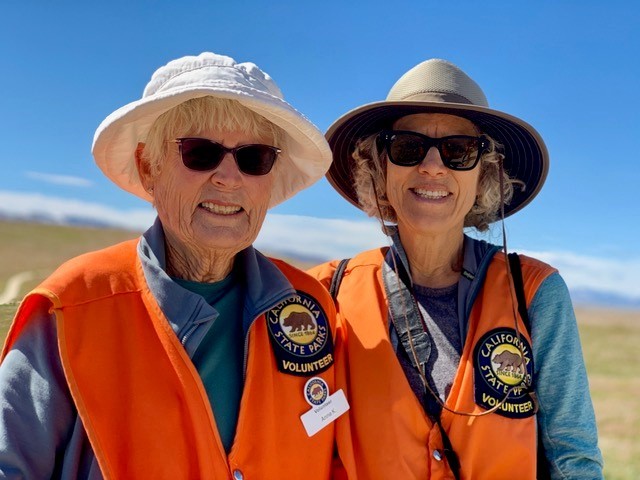 Antelope Valley California Poppy Reserve
State Natural Reserve
Volunteer Susan Burke walks with her mother, Anne Klittz, at the reserve. Multigenerational volunteering!
Photo from Callista Turner, Great Basin District
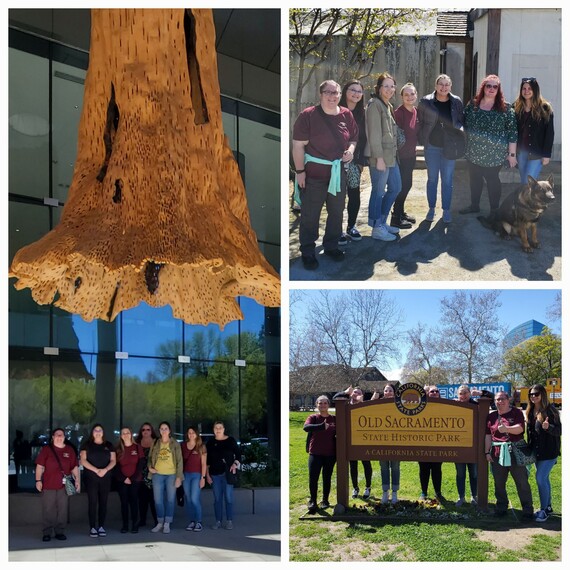 Sacramento, California
The Gold Fields District Administrative Team took advantage of the nice weather on Monday April 3, to see some sights right in their own backyard, including the California Natural Resources Agency (CNRA) Headquarters building, Old Sacramento State Historic Park and the California State Railroad Museum.
Left: Outside the CNRA building. Left to right: Administrative Officer I Carissa Barnett, Office Technician Kasie Greene, Management Services Technician Ashton Hosmann, Associate Governmental Program Analyst Holly Welch, Staff Services Manager II Brandy Greene, Staff Services Analyst Jill Brandt and Staff Services Analyst Cherly La Jeunesse. Top right (left to right): Carissa, Kasie, Brandy, Ashton, Cherly, Associate Governmental Program Analyst Holly Welch and Jill Brandt with K-9 Hugo. Bottom right (left to right): Ashton, Kasie, Brandy, Holly, Cherly, Carissa Barnett and Jill.
Photos from Carissa Barnett, Gold Fields District
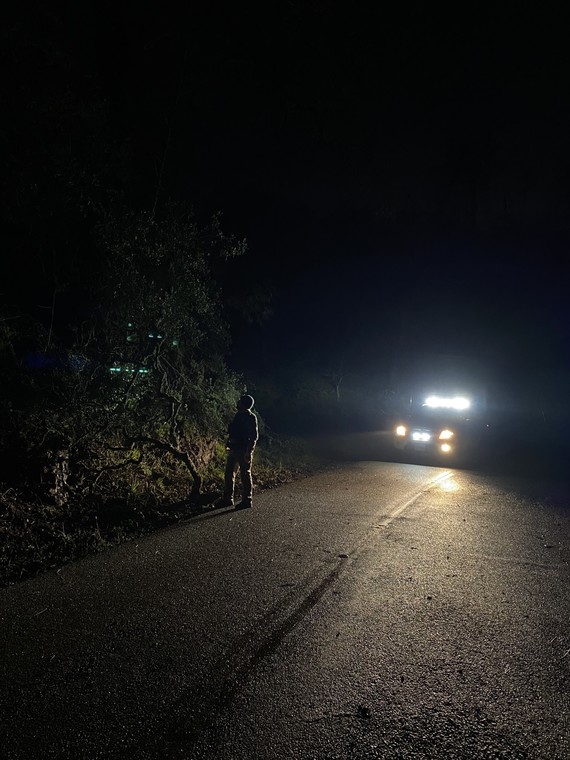 Mount Diablo State Park
Ranger John Baxter contemplating the meaning of life and how to remove a downed tree limb.
Photo from Jessica Sears, Diablo Range District
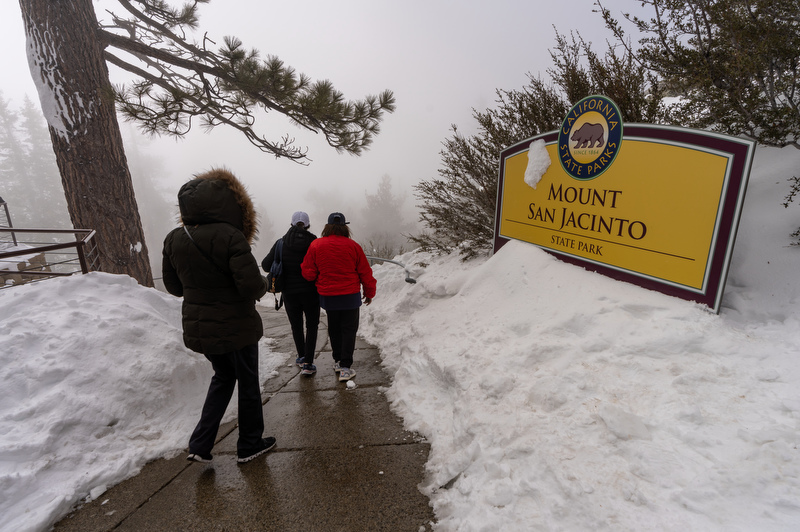 Mount San Jacinto State Park
Visitors at the top of the park after several days of snow.
Photo from Brian Baer, Communications and Marketing Division
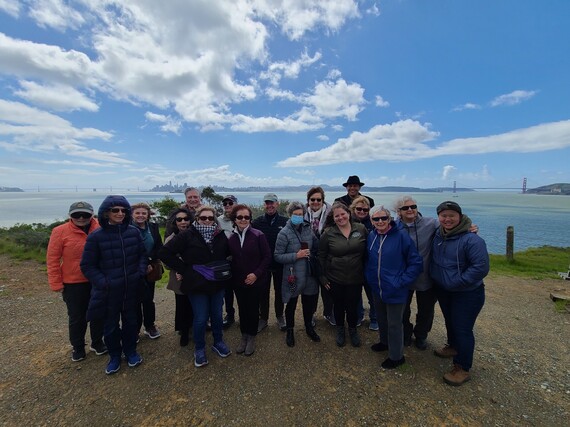 Angel Island State Park
The California State Capitol Museum Volunteer Association had an amazing trip to the park. State Park Interpreter I Erin Dunning gave a guided tour of the island and the Immigration Station. We had a fantastic trip. Also pictured are Leland Stanford Mansion Guide II Megan Stanley and California State Capitol Guide Trainee Isabel Nguyen.
Photo from Megan Stanley, Capital District
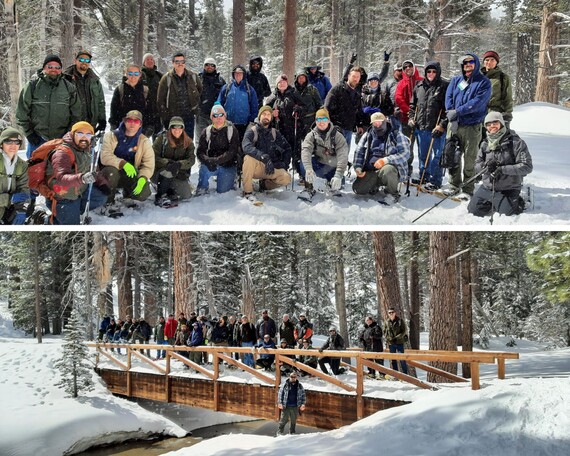 Mount San Jacinto State Park
Staff visited the park during the annual District Trails Coordinator Training held during the Trails and Greenways Conference in Palm Springs, California, from March 27 to 31. These pictures were taken in Long Valley on the Discovery Trail during our field day.
Photo from Nick Garduno, Inland Empire District
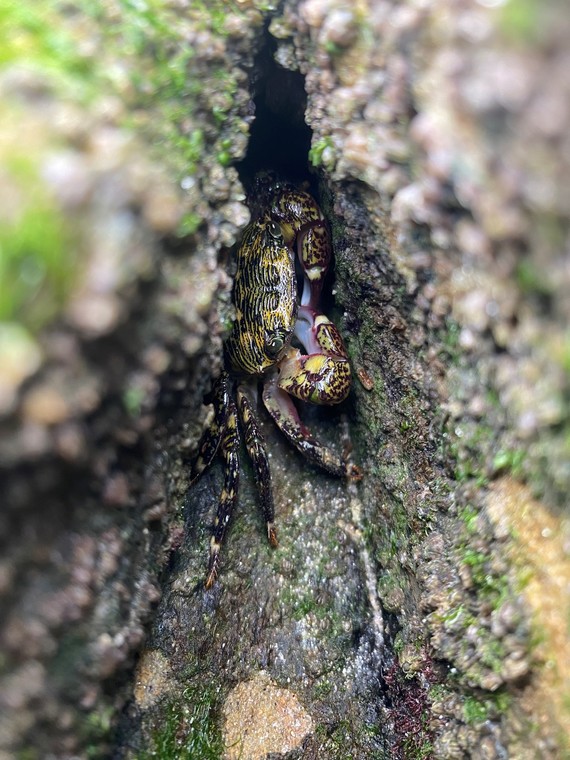 Torrey Pines State Natural Reserve
Striped shore crab hiding between rocks at the flat rock tide pools.
Photo from Courtney Mullen, San Diego Coast District
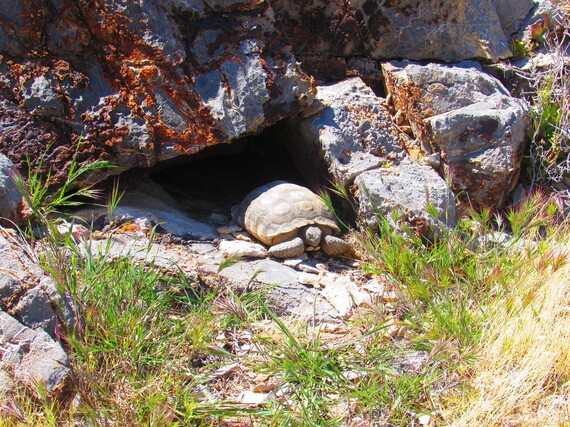 Providence Mountains State Recreation Area
Saturday, April 1, was an auspicious local holiday here at the park, the Home of Mitchell Caverns. While it was also April Fool's Day, we are referencing First Tortoise of the Year Day! No, we are not joking. When we spotted this fellow sunning himself outside his burrow, there was much rejoicing. Yay!
If you are traveling to or through the Mojave Desert in the coming weeks, please pay extra attention to the roads. Desert tortoises (Gopherus agassizii) are waking from a long winter slumber, and they are hungry and ready to mix and mingle. SLOW DOWN BEHIND THE WHEEL and, remember, never touch a tortoise unless it is in danger of being hit.
Photo from Andrew Fitzpatrick, Inland Empire District
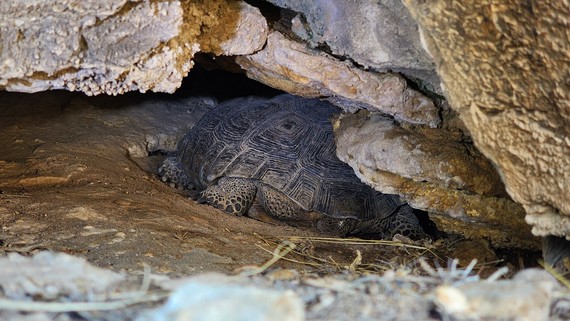 Providence Mountains State Recreation Area
The long and cold winter season across the state has us feeling cooped up and running a temperature from low-grade cabin fever—probably a bit like a desert tortoise (Gopherus agassizii) feels after months in its burrow.
Still cold and wet here in the Mojave. Never-ending winter.
Photo from Andrew Fitzpatrick, Inland Empire District
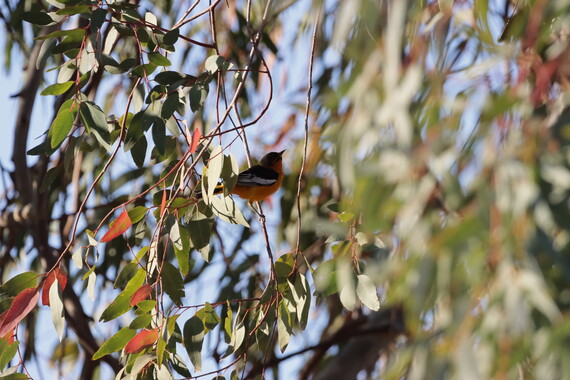 Picacho State Recreation Area
A bullocks oriole.
Photo from Jared Gravett, Ocotillo Wells District
 State Indian Museum State Historic Park
New life—baby geese—springs forward at the park's pond.
Photo from Michael Ramirez, Capital District
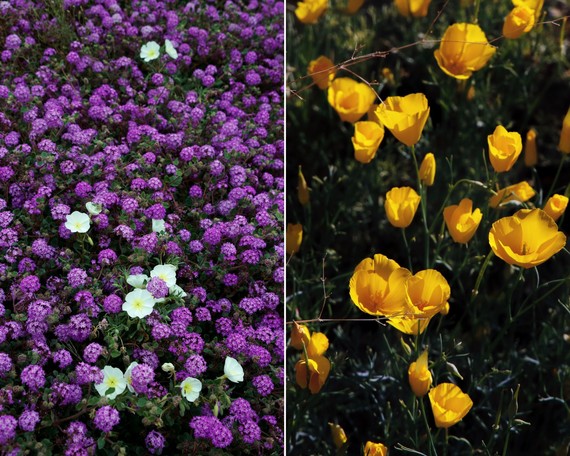 Anza-Borrego Desert State Park
It’s a nice change being in the desert where it’s not so cold and windy. The park has some amazing flower blooms, such as the sand verbena, with a few dune evening-primrose (left) and Parish’s poppies (right).
Photos from Michele Hernandez, Colorado Desert District
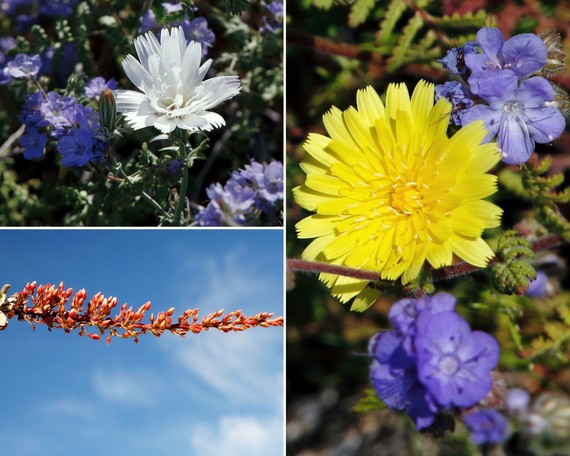 Anza-Borrego Desert State Park
The desert showing its beautiful colors in the form of flowers. Top left: Desert chicory with common phacelia. Bottom left: Ocotillo blossom. Right: Desert dandelion with common phacelia.
Photos from Michele Hernandez, Colorado Desert District
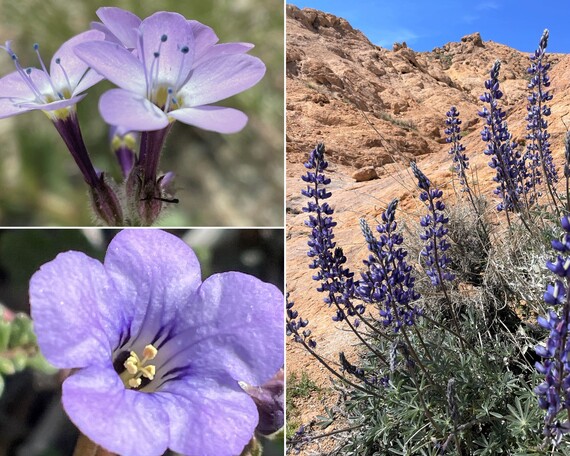 Eastern Kern County Onyx Ranch
State Vehicular Recreation Area
Flowers blooming at the park captured this past week while doing vegetation surveys. Top left: Showy gilia. Bottom left: Fremont's phacelia. Right: Silver bush lupine.
Photos from Leah Gardner, Natural Resources Division
 Eastern Kern County Onyx Ranch
State Vehicular Recreation Area
Flowers blooming at the park. Top: Coreopsis (left) and cream cups (right). Bottom: Chia (left) and blazing star (right).
Photos from Leah Gardner, Natural Resources Division
 Mount Diablo State Park
California poppies with a view! Talk about the best seat in the house, or in this case, the best seat on the mountain.
Photo from Jessica Sears, Diablo Range District
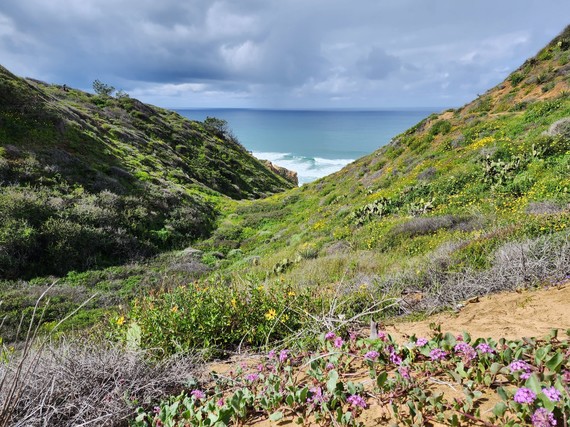 Torrey Pines State Natural Reserve
Flowers blooming on Guy Fleming Trail.
Photo from Barbara Green, San Diego Coast District
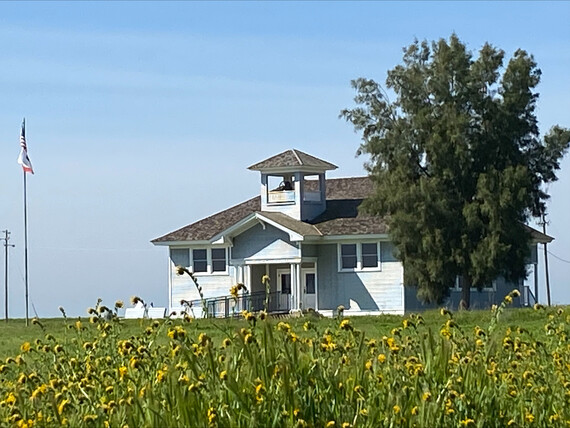 Colonel Allensworth State Historic Park
Spring has arrived at the park.
Photo from Lori Wear, Great Basin District
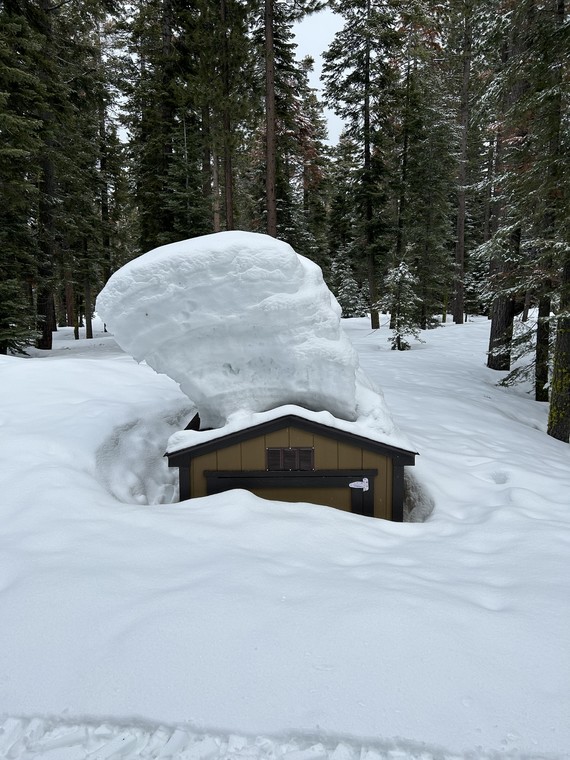 Ed Z'berg Sugar Pine Point State Park
A firewood shed on the back loop of the park along the XC ski trail. This is after a couple of days' break in the weather but more on the way …
Photo from Ryan Marino, Sierra District
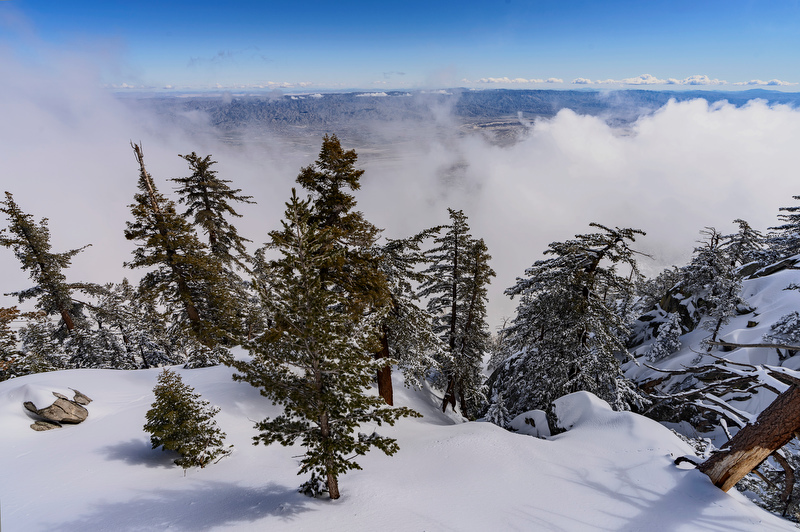 Mount San Jacinto State Park
Clouds obscure the view of the valley from atop the mountain with the park covered in snow.
Photo from Brian Baer, Communications and Marketing Division
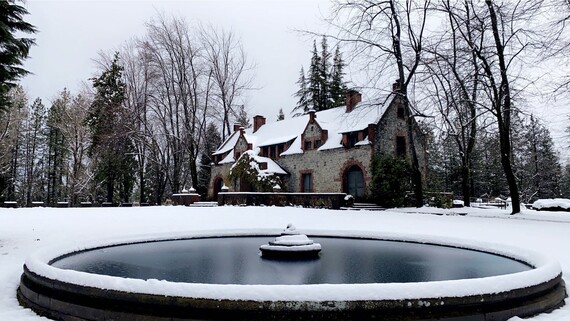 Empire Mine State Historic Park
Snow lingers on the grounds and rooftop of the Empire Cottage, after a late season snowstorm brings 6 inches of snow. Photo was taken on Wednesday, March 29.
Photo from Caleb Longest, Sierra District
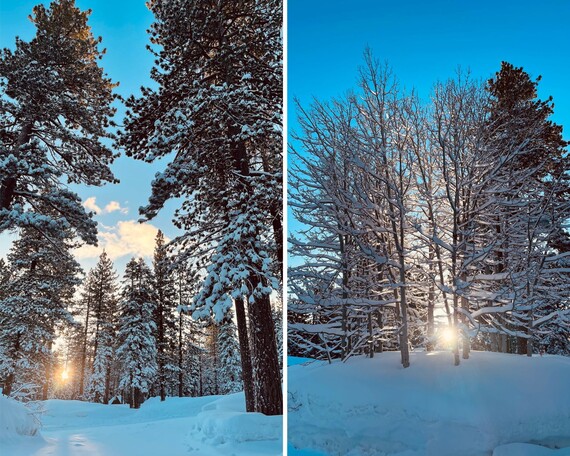 Ed Z'berg Sugar Pine Point State Park
Here are a couple of morning photos before the snowplows came through. Spring at 6,200 feet looks a little different here with fresh snow this early March morning.
Photos from Ryan Howard, Sierra District
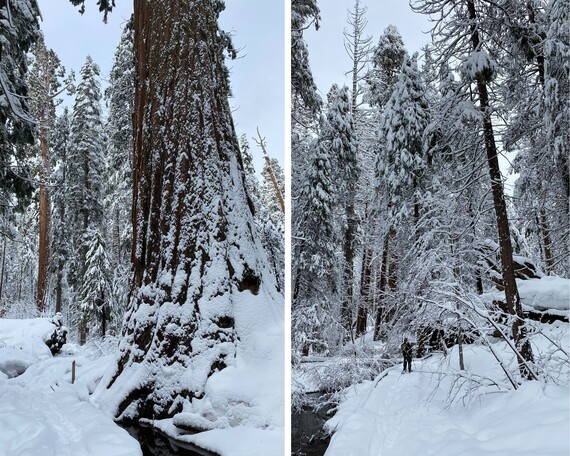 Calaveras Big Trees State Park
Breaking the North Grove Trail on Wednesday, March 29. We're hoping this is the last major snowfall for a while!
Photos from Lillie Oravetz, Central Valley District
 Doheny State Beach
It's never too late to share a beautiful sunset photo from a beach, even if it was taken in December 2022.
Photo from Daryl Lucarelli, Orange Coast District

Montaña de Oro State Park
A rainbow above Spooners Cove.
Photo from Gerry Lopez, San Luis Obispo Coast District
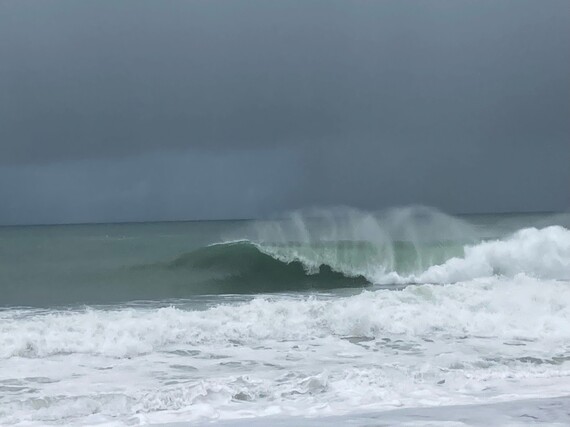 North Coast Redwoods District
A cold, big and beautiful wave in the district.
Photo from Keven Harder, North Coast Redwoods District
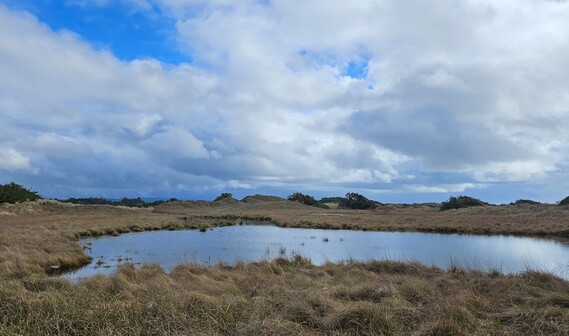 Tolowa Dunes State Park
April showers bring dune wetlands to the rugged expanse.
Photo from Simone DuRand, North Coast Redwoods District
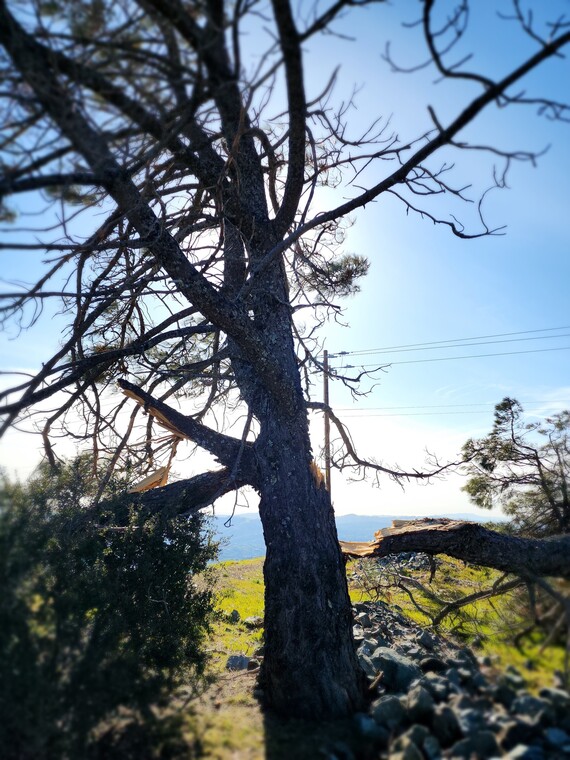 Mount Diablo State Park
A whole new take on the term "split ends." High winds have wreaked havoc at the park for months, creating tremendous damage to facilities and nature alike.
Photo from John T. Baxter, Diablo Range District
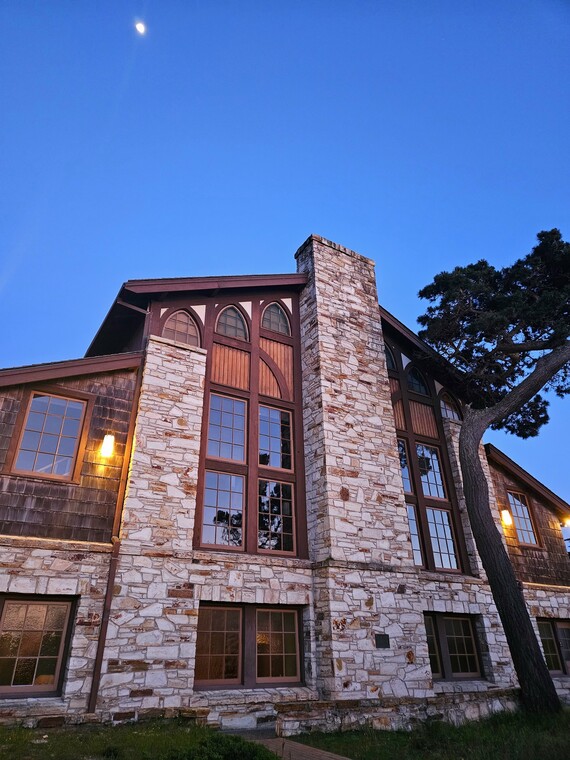 Asilomar State Beach and Conference Grounds
Merrill Hall, designed by architect Julia Morgan in 1928, stands tall.
Photo from Simone DuRand, North Coast Redwoods District
 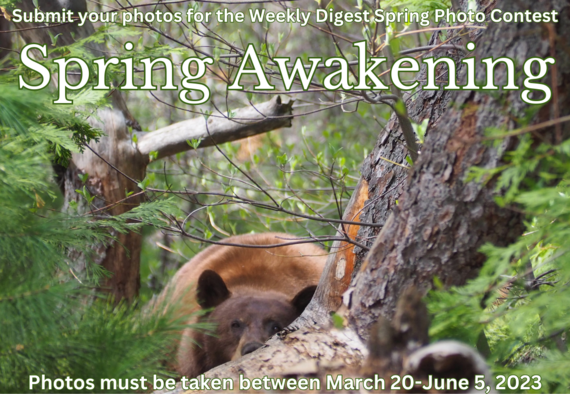 Email photos to the WeeklyDigest@parks.ca.gov.
|
|
|
March 28, 2023
March 29, 2023
April 3, 2023
April 4, 2023
April 5, 2023

|
|
|
The Weekly Digest includes a collection of news articles related to the
California Department of Parks and Recreation. The views expressed and opinions do not always reflect that of the department.
To view this week's News Clips, please visit www.parks.ca.gov/NewsClips.
  Weekly Digest Article and Photo Submissions
If you have an article or photo you would like to submit for the Weekly Digest, please send your entries via email to WeeklyDigest@parks.ca.gov.
For an article submission, please include:
- Author’s name and division/district.
- All relevant information (e.g., headline, park name, dates, name of event, individuals’ full names and titles, etc.).
Articles should be no longer than 300 words.
For photos, please include:
- Photo credit info and captions.
- Photo release forms should be kept on file for non-employees or volunteers.
Unless otherwise noted, all photos included in the Weekly Digest are courtesy of the California Department of Parks and Recreation.
The deadline for Weekly Digest submissions is close of business Thursday. For more information, email WeeklyDigest@parks.ca.gov.
|
|
|
|
|